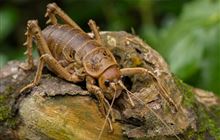Critically endangered snail doing well in Abel Tasman
Archived content: This media release was accurate on the date of publication.
Introduction
A survey of carnivorous land snails in Abel Tasman National Park has found a critically endangered species is much more widespread than previously thought.Date: 21 July 2016 Source: Project Janszoon
The Rhytida oconnori snail is found at only two sites in New Zealand, in the Abel Tasman and at Parapara Peak in Golden Bay. Biodiversity ranger Mike Ogle says proof the critically endangered snail is more prevalent in the park than earlier thought is great news.
"To put this in context, if the Rhytida oconnori had feathers it would be the equivalent of a kakapo as they are both classified nationally critical. Imagine finding you had 20% more kakapo than thought, people would be popping the champagne corks," he says.
DOC undertook the survey as part of Project Janszoon's work to restore the ecology of the Abel Tasman National Park. Project Janszoon wanted to better understand the distribution of both the Rhytida oconnori and Powelliphanta hochstetteri hochstetteri (P. h. hochstetteri).
"These snails are not like your common garden snails. Powelliphanta snails are large with deep rich mahogany and gold colouring, many with attractive patterns. With Rhytida oconnori the beauty is on the inside as its inner shell is like glossy mother of pearl," says Mike Ogle.
While historically R.oconnori would have had a wider distribution, as recently as 1998 this snail was reported as having been reduced to surviving within a 1km radius of Pages Saddle near Harwoods Hole. However this survey found evidence of the land snail up to 9km east and north-east of this area, with most south and west of Awaroa estuary. The nationally vulnerable P. h. hochstetteri was found further east and west than previously thought. A further positive surprise was finding a high number of P. h. hochstetteri shells at Waterfall Creek, an area previously considered to be probably out of its range.
Both species are vulnerable to predators with the R. oconnori being smaller with a more fragile shall than the P.hochstetteri. The survey found rats were the most common predator.
Project Janszoon Operations Manager Andrew Macalister says this survey has highlighted the need to extend predator control in the Park.
"People do get a thrill from encountering land snails and they are a really important part of our natural heritage. This information will be used when we are planning our predator control in these areas," he says.
Previous studies have shown numbers of both snails are in decline. DOC is planning to do some more intensive snail monitoring in the area.
Contact
Mike Ogle, DOC Biodiversity Ranger
Phone: +64 027 525 9295


